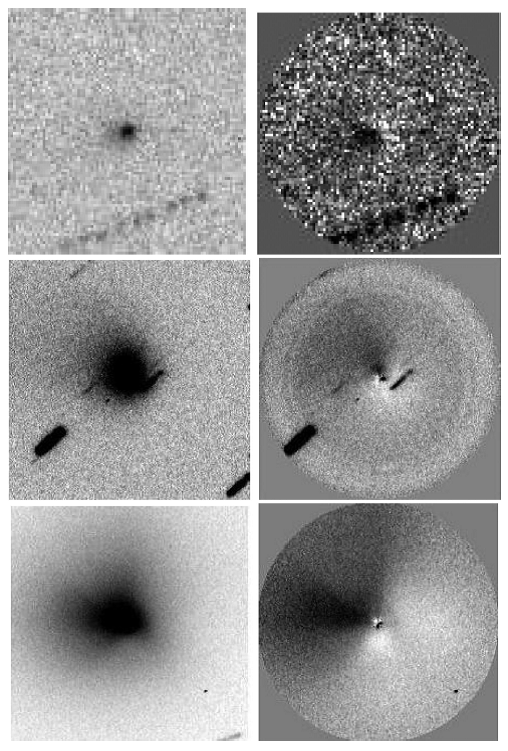Generally, a comet at a large distance from the Sun is supposed to be inactive due to the low temperature and the absence of gas sublimation leading to coma formation. But it is known from observations that the activity of comets far from the Sun is common. The primary driver of activity in comets close to the Sun is sublimation of water ice and can be explained by the standard model. Beyond a heliocentric distance of 3~5 au, the activity of comets must be explained by other mechanisms. The objects of our observation are comets at heliocentric distances larger than 3 au. By cometary morphological analysis we find that all three comets were observed to be active at heliocentric distances larger than 3 au (Fig. 1). 
(By with SHI Jianchun) Figure 1. Coma structures of comets 228P/LINEAR (top), C/2006 S3 (LONEOS) (middle) and 29P/Schwassmann–Wachmann 1 (bottom) in the R filter on 2011 April 6. First column shows co-added images, second column shows radial renormalization enhancement of the final images. All images are oriented north-up, east-left. The FOVof 228P/LINEAR is 0.53×0.53 arcmin2. The FOVs of C/2006 S3 (LONEOS) and 29P/Schwassmann–Wachmann 1 are 1.29 × 1.29 arcmin2. The scales of the processed images are the same as those of the unprocessed images.
The surface brightness profiles of the comets show that all three comets can be explained by a solar radiation pressure model. Dust production and mass production rates of three comets were estimated. Afρ and Qdust of comet 228P/LINEAR were about 44 cm and 6.9 kg s−1, respectively. Afρ and Qdust of comet C/2006 S3 (LONEOS) were about 2964.4 cm and 360.1 kg s−1, respectively. Afρ andQdust of comet 29P/Schwassmann–Wachmann 1 were about 3665.4 cm and 431.0 kg s−1, respectively. The results demonstrate that 228P/LINEAR has a lower activity, while C/2006 S3 (LONEOS) and 29P/Schwassmann–Wachmann 1 have higher activity even at large heliocentric distances. The coma colour indices of comet 228P/LINEAR are B − V = 0.78 ± 0.07 and V − R = 0.83 ± 0.04. The average coma colour index of comet C/2006 S3 (LONEOS) are B − V = 0.67 ± 0.01 and V − R = 0.43 ± 0.01. The average coma colour indices of comet 29P/Schwassmann–Wachmann 1 are B − V = 0.84 ± 0.01 and V − R = 0.48 ± 0.01. For comet 228P/LINEAR,water ice sublimation driven activity is possible. For comet 29P/Schwassmann–Wachmann 1, activity could be explained by the sublimation or the release of CO and/or CO2. For comet C/2006 S3 (LONEOS), CO sublimation driven activity is a possible mechanism, but more observation data are needed. The work by J. C. Shi, Y. H. Ma, J. Q. Zheng has been published in MNRAS. http://mnras.oxfordjournals.org/content/441/1/739.full.pdf+html |
